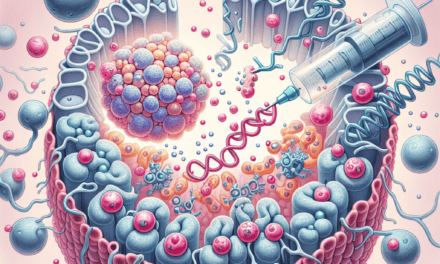5 Effective Natural Solutions for Chronic Migraine Relief
Chronic migraines can be debilitating, affecting millions of people worldwide. While traditional medications can provide relief, they often come with side effects and may not work for everyone. Fortunately, there are natural solutions that can help alleviate migraine symptoms and improve quality of life. In this article, we will explore five effective natural solutions for chronic migraine relief, backed by research and real-life examples.
1. Dietary Modifications
Diet plays a crucial role in managing migraines. Certain foods can trigger migraines, while others can help prevent them. Understanding how to modify your diet can lead to significant improvements in migraine frequency and intensity.
Identifying Trigger Foods
Many individuals with chronic migraines report specific foods that trigger their headaches. Common culprits include:
- Processed meats (e.g., hot dogs, bacon)
- Aged cheeses (e.g., cheddar, blue cheese)
- Fermented foods (e.g., sauerkraut, kimchi)
- Alcohol, particularly red wine
- Caffeinated beverages
- Chocolate
Keeping a food diary can help identify personal triggers. By tracking what you eat and when migraines occur, you can pinpoint specific foods that may be contributing to your headaches.
Incorporating Migraine-Friendly Foods
In addition to avoiding trigger foods, incorporating certain migraine-friendly foods can be beneficial. These include:
- Leafy greens (e.g., spinach, kale)
- Fatty fish (e.g., salmon, mackerel)
- Nuts and seeds (e.g., almonds, flaxseeds)
- Whole grains (e.g., brown rice, quinoa)
- Fruits and vegetables rich in magnesium (e.g., bananas, avocados)
Research has shown that magnesium deficiency is linked to migraines. A study published in the journal “Headache” found that magnesium supplementation reduced the frequency of migraines in participants. Therefore, ensuring adequate magnesium intake through diet or supplements may help mitigate migraine symptoms.
Hydration and Its Impact
Dehydration is another common trigger for migraines. Maintaining proper hydration is essential for overall health and can significantly impact migraine frequency. Aim to drink at least eight 8-ounce glasses of water daily, and consider increasing your intake during hot weather or after exercise.
In summary, dietary modifications can play a vital role in managing chronic migraines. By identifying trigger foods, incorporating migraine-friendly options, and staying hydrated, individuals can take proactive steps toward relief.
2. Herbal Remedies
Herbal remedies have been used for centuries to treat various ailments, including migraines. Several herbs have shown promise in reducing the frequency and severity of migraine attacks.
Feverfew
Feverfew (Tanacetum parthenium) is one of the most researched herbs for migraine relief. Studies have shown that feverfew can reduce the frequency of migraines and the severity of symptoms. A meta-analysis published in the “British Medical Journal” found that feverfew significantly reduced the number of migraine attacks in participants compared to a placebo.
Feverfew is typically taken in capsule form or as a tea. However, it is essential to consult with a healthcare provider before starting any herbal supplement, as it may interact with other medications.
Butterbur
Butterbur (Petasites hybridus) is another herb that has gained attention for its migraine-relieving properties. Research published in the journal “Neurology” found that butterbur extract significantly reduced the frequency of migraines in participants. The study reported that those taking butterbur experienced fewer migraine days compared to those taking a placebo.
Butterbur should be taken in a standardized extract form, and it is crucial to use only products that are free of pyrrolizidine alkaloids, which can be harmful to the liver.
Ginger
Ginger (Zingiber officinale) is a common kitchen spice known for its anti-inflammatory properties. Some studies suggest that ginger may help alleviate migraine symptoms. A study published in the journal “Phytotherapy Research” found that ginger powder was as effective as sumatriptan, a common migraine medication, in reducing migraine pain.
Ginger can be consumed in various forms, including fresh ginger tea, ginger capsules, or ginger-infused foods. Its anti-nausea properties can also be beneficial for those who experience nausea during migraines.
Other Herbal Options
Other herbs that may provide migraine relief include:
- Lavender: Known for its calming effects, lavender essential oil can be used in aromatherapy to reduce migraine symptoms.
- Peppermint: The menthol in peppermint oil can help relieve tension headaches and migraines when applied topically.
- Chamomile: Chamomile tea can promote relaxation and may help reduce migraine frequency.
While herbal remedies can be effective, it is essential to consult with a healthcare professional before starting any new treatment, especially if you are pregnant, nursing, or taking other medications.
3. Mindfulness and Stress Management
Stress is a significant trigger for many individuals suffering from chronic migraines. Implementing mindfulness and stress management techniques can help reduce the frequency and severity of migraine attacks.
The Role of Mindfulness
Mindfulness involves being present in the moment and can help individuals manage stress more effectively. Research has shown that mindfulness-based interventions can reduce the frequency of migraines. A study published in the journal “Headache” found that participants who practiced mindfulness meditation experienced fewer migraine days compared to those who did not.
Mindfulness techniques can include:
- Meditation: Practicing meditation for even a few minutes daily can help calm the mind and reduce stress.
- Deep breathing exercises: Focusing on deep, slow breaths can help alleviate tension and promote relaxation.
- Body scan: This technique involves mentally scanning the body for tension and consciously relaxing each muscle group.
Yoga and Physical Activity
Regular physical activity, including yoga, can also help manage stress and reduce migraine frequency. A study published in the journal “Headache” found that participants who practiced yoga experienced a significant reduction in migraine days and intensity.
Yoga combines physical movement with mindfulness, making it an excellent option for stress relief. Poses that focus on relaxation and stretching, such as child’s pose, forward bends, and gentle twists, can be particularly beneficial for those with migraines.
Cognitive Behavioral Therapy (CBT)
Cognitive Behavioral Therapy (CBT) is a psychological intervention that can help individuals manage stress and anxiety, which are often linked to migraines. A study published in the journal “Pain” found that CBT significantly reduced the frequency of migraines in participants compared to a control group.
CBT focuses on changing negative thought patterns and behaviors that contribute to stress. Working with a trained therapist can help individuals develop coping strategies and improve their overall mental well-being.
Creating a Stress-Reduction Routine
Incorporating stress-reduction techniques into your daily routine can be highly beneficial. Consider the following:
- Set aside time for relaxation each day, whether through meditation, yoga, or simply enjoying a quiet moment.
- Engage in regular physical activity to release endorphins and reduce stress levels.
- Practice gratitude by keeping a journal to reflect on positive experiences and reduce negative thinking.
By prioritizing mindfulness and stress management, individuals can take proactive steps toward reducing the impact of stress on their migraines.
4. Acupuncture and Alternative Therapies
Acupuncture and other alternative therapies have gained popularity as natural solutions for chronic migraine relief. These therapies focus on holistic healing and can provide significant benefits for migraine sufferers.
Acupuncture
Acupuncture involves inserting thin needles into specific points on the body to promote healing and balance. Research has shown that acupuncture can be effective in reducing the frequency and intensity of migraines. A meta-analysis published in the journal “Archives of Internal Medicine” found that acupuncture was more effective than no treatment and comparable to conventional migraine medications.
Acupuncture may help by:
- Reducing inflammation
- Promoting relaxation
- Improving blood flow
It is essential to seek treatment from a licensed acupuncturist who has experience in treating migraines. Many individuals report positive results after several sessions.
Massage Therapy
Massage therapy can also provide relief for chronic migraines. A study published in the journal “Headache” found that participants who received regular massage therapy experienced a significant reduction in migraine frequency and intensity.
Massage can help alleviate muscle tension, improve circulation, and promote relaxation. Techniques such as Swedish massage, deep tissue massage, and trigger point therapy can be particularly effective for migraine sufferers.
Chiropractic Care
Chiropractic care focuses on the alignment of the spine and musculoskeletal system. Some studies suggest that chiropractic adjustments can help reduce the frequency and severity of migraines. A study published in the journal “Journal of Manipulative and Physiological Therapeutics” found that chiropractic care significantly reduced migraine frequency in participants.
Chiropractors may use various techniques, including spinal manipulation and soft tissue therapy, to address underlying issues contributing to migraines.
Other Alternative Therapies
Other alternative therapies that may provide relief include:
- Biofeedback: This technique teaches individuals to control physiological functions, such as heart rate and muscle tension, to reduce migraine symptoms.
- Essential oils: Aromatherapy with essential oils like lavender and peppermint can promote relaxation and alleviate headache symptoms.
- Physical therapy: Targeted exercises and stretches can help address muscle tension and improve posture, reducing migraine triggers.
While alternative therapies can be effective, it is essential to consult with a healthcare professional before starting any new treatment, especially if you have underlying health conditions.
5. Lifestyle Changes
Making specific lifestyle changes can significantly impact the frequency and severity of chronic migraines. By adopting healthier habits, individuals can take control of their migraine management.
Establishing a Consistent Sleep Schedule
Sleep disturbances are a common trigger for migraines. Establishing a consistent sleep schedule can help regulate sleep patterns and reduce the likelihood of migraines. Aim for 7-9 hours of quality sleep each night, and try to go to bed and wake up at the same time every day.
Consider creating a relaxing bedtime routine that includes:
- Avoiding screens at least an hour before bed
- Practicing relaxation techniques, such as deep breathing or meditation
- Creating a comfortable sleep environment (dark, cool, and quiet)
Regular Exercise
Regular physical activity can help reduce stress, improve sleep quality, and promote overall health. A study published in the journal “Headache” found that individuals who engaged in regular exercise experienced fewer migraines compared to those who were sedentary.
Consider incorporating activities such as:
- Walking or jogging
- Swimming
- Cycling
- Yoga or Pilates
Start slowly and gradually increase the intensity and duration of your workouts. Aim for at least 150 minutes of moderate-intensity exercise each week.
Avoiding Overuse of Medications
Overuse of pain medications can lead to rebound headaches, which can exacerbate migraine symptoms. It is essential to use medications as directed and consult with a healthcare provider if you find yourself relying on them frequently.
Consider discussing alternative pain management strategies with your healthcare provider, including natural solutions and lifestyle changes.
Creating a Supportive Environment
Creating a supportive environment can also play a significant role in managing chronic migraines. Consider the following:
- Communicate with family and friends about your condition to foster understanding and support.
- Identify and minimize environmental triggers, such as bright lights, loud noises, or strong odors.
- Consider joining a support group for individuals with chronic migraines to share experiences and coping strategies.
By making these lifestyle changes, individuals can take proactive steps toward managing their chronic migraines and improving their overall well-being.
Conclusion
Chronic migraines can be challenging to manage, but natural solutions offer hope for relief. By exploring dietary modifications, herbal remedies, mindfulness and stress management techniques, alternative therapies, and lifestyle changes, individuals can take control of their migraine management.
It is essential to remember that what works for one person may not work for another. Therefore, it is crucial to consult with a healthcare professional before starting any new treatment or making significant lifestyle changes. With patience and persistence, individuals can find effective natural solutions for chronic migraine relief and improve their quality of life.





